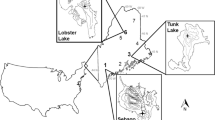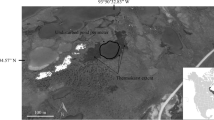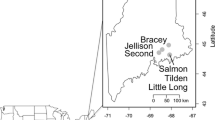Abstract
Monitoring during three meteorologically different spring seasons in 2012, 2013, and 2014 revealed that temperature increase in spring, which influences spring lake mixing duration, markedly affected nutrient availability and diatom deposition in a sediment trap close to the bottom of deep Tiefer See, NE Germany. Deposition of Stephanodiscus taxa and small Cyclotella taxa was much higher after late ice out and a deep, short lake mixing period in spring 2013, compared to that after gradual warming and lengthy lake mixing periods in spring 2012 and 2014, when only brief or marginal ice cover occurred. Availability of dissolved Si and P was 33 and 20 % higher, respectively, in 2013 compared to 2014. The observed relation between high (low) diatom deposition and short (lengthy) mixing duration in spring was applied to varved sediments deposited between AD 1924 and 2008. Low detrital Si content in trapped material and a sediment core enabled use of µXRF-counts of Si as a proxy for diatom silica. The spring mixing duration for 1951–2008 was derived from FLake-model calculations. The spring warming duration related to lake mixing was approximated from air temperatures for 1924–2008 using the dates when daily mean air temperature exceeded 5 °C (start) and 10 °C (end). Diatom silica deposition showed a significant (p < 0.0001) inverse linear relationship with the modeled spring mixing duration (R2 = 0.36) and the spring warming duration (R2 = 0.28). In both cases, the relationship is strengthened when data from the period of low diatom production (1987–2005) is excluded (R2 = 0.59 and R2 = 0.35). Part of this low diatom production is related to external nutrient supply that favored growth of cyanobacteria at the expense of diatoms. This approach shows that diatom Si deposition was strongly influenced by the availability of light and nutrients, related to the duration of lake mixing and warming in spring, during most of the studied period. The remaining unexplained variability, however, indicates that additional factors influence Si deposition. Further tests in other deep, temperate lakes are necessary to verify if this relation is a common feature and consequently, if diatom Si can be used as a proxy for spring mixing duration in such lakes.





Similar content being viewed by others
References
Battarbee R, Kneen MJ (1982) The use of electronically counted microspheres in absolute diatom anaysis. Limnol Oceanogr 27:184–188
Berger SA, Diehl S, Stibor H, Trommer G, Ruhenstroth M (2010) Water temperature and stratification depth independently shift cardinal events during plankton spring succession. Glob Change Biol 16:1954–1965
Blenckner T, Adrian R, Livingstone DM, Jennings E, Weyhenmeyer GA, George DG, Jankowski T, Järvinen M, Aonghusa CN, Nöges T, Straile D, Teubner K (2007) Large-scale climatic signatures in lakes across Europe: a meta-analysis. Glob Change Biol 13:1314–1326
Bradbury JP, Colman SM, Reynolds RL (2004) The history of recent limnological changes and human impact on Upper Klamath Lake, Oregon. J Paleolimnol 31:151–165
Brauer A, Casanova J (2001) Chronology and depositional processes of the laminated sediment record from Lac d‘Annecy, French Alps. J Paleolimnol 25:163–177
Conley DJ, Kilham SS, Theriot EC (1989) Differences in silica content between marine and freshwater diatoms. Limnol Oceanogr 34:205–213
Croudace IW, Rindby A, Rothwell RG (2006) ITRAX: description and evaluation of a new multi-function X-ray core scanner. Geol Soc Lond Spec Publ 267:51–63
Davis TW, Harke MJ, Marcoval M, Goleski J, Orano-Dawson C, Berry DL, Gobler CJ (2010) Effects of nitrogenous compounds and phosphorus on the growth of toxic and non-toxic strains of Microcystis during cyanobacterial blooms. Aquat Microb Ecol 61:149
Dokulil M, Teubner K (2000) Cyanobacterial dominance in lakes. Hydrobiologia 438:1–12
Engel F (1961) Blatt 24 Krakow am See der Wiebekingschen Karte. Historischer Atlas von Mecklenburg, Wiebeking, CF (1755–1788) Böhlau, Köln, Graz
Huisman J, Sharples J, Stroom JM, Visser PM, Kardinaal WEA, Verspagen JMH, Sommeijer B (2004) Changes in turbulent mixing shift competition for light between phytoplankton species. Ecology 85:2960–2970
Jäger CG, Diehl S, Matauschek C, Klausmeier CA, Stibor H (2008) Transient dynamics of pelagic producer-grazer systems in a gradient of nutrients and mixing depths. Ecology 89:1272–1286
Jäger CG, Diehl S, Emans M (2010) Physical determinants of phytoplankton production, algal stoichiometry, and vertical nutrient fluxes. Am Nat 175:E91–E104
Jeppesen E, Jensen JP, Søndergaard M, Lauridsen T, Pedersen LJ, Jensen J (1997) Top-down control in freshwater lakes: the role of nutrient state, submerged macrophytes and water depth. Hydrobiologia 342(343):151–164
Jöhnk KD, Huisman JEF, Sharples J, Sommeijer BEN, Visser PM, Stroom JM (2008) Summer heatwaves promote blooms of harmful cyanobacteria. Glob Change Biol 14:495–512
Kelts K, Briegel U, Ghilardi K, Hsü K (1986) The limnogeology-ETH coring system. Schweiz Z Hydrol 48:104–115
Kienel U, Dulski P, Ott F, Lorenz S, Brauer A (2013) Recently induced anoxia leading to the preservation of seasonal laminae in two NE-German lakes. J Paleolimnol 50:535–544
Kirillin G (2010) Modeling the impact of global warming on water temperature and seasonal mixing regimes in small temperate lakes. Boreal Environ Res 15:279–293
Kirillin G, Leppäranta M, Terzhevik A, Granin N, Bernhardt J, Engelhardt C, Efremova T, Golosov S, Palshin N, Sherstyankin P, Zdorovennova G, Zdorovennov R (2012) Physics of seasonally ice-covered lakes: a review. Aquat Sci 74:659–682
Kirillin G, Shatwell T, Kasprzak P (2013) Consequences of thermal pollution from a nuclear plant on lake temperature and mixing regime. J Hydrol 496:47–56
Krammer K, Lange-Bertalot H (1991) Bacillariophyceae (Centrales, Fragilariaceae, Eunotiaceae). Fischer, Stuttgart, p 576
Menzel A, Jakobi G, Ahas R, Scheifinger H, Estrella N (2003) Variations of the climatological growing season (1951–2000) in Germany compared with other countries. Int J Climatol 23:793–812
Mironov DV (2008) Parameterization of lakes in numerical weather prediction. Description of a lake model, vol 11. COSMO Technical Report. Deutscher Wetterdienst, pp 1–41
O’Neil J, Davis TW, Burford MA, Gobler C (2012) The rise of harmful cyanobacteria blooms: the potential roles of eutrophication and climate change. Harmful Algae 14:313–334
Paerl H, Otten T (2013) Harmful cyanobacterial blooms: causes, consequences, and controls. Microb Ecol 65:995–1010
Peeters F, Straile D, Lorke A, Livingstone DM (2007a) Earlier onset of the spring phytoplankton bloom in lakes of the temperate zone in a warmer climate. Glob Change Biol 13:1898–1909
Peeters F, Straile D, Lorke A, Ollinger D (2007b) Turbulent mixing and phytoplankton spring bloom development in a deep lake. Limnol Oceanogr 52:286–298
Peeters F, Kerimoglu O, Straile D (2013) Implications of seasonal mixing for phytoplankton production and bloom development. Theor Ecol 6:115–129
Posch T, Koster O, Salcher MM, Pernthaler J (2012) Harmful filamentous cyanobacteria favoured by reduced water turnover with lake warming. Nat Clim Change 2:809–813
Reynolds CS (1984) The ecology of freshwater phytoplankton. Cambridge University Press, Cambridge, p 384
Rühland K, Paterson A, Smol JP (2015) Lake diatom responses to warming: reviewing the evidence. J Paleolimnol 54:1–35
Shatwell TOM, Köhler J, Nicklisch A (2008) Warming promotes cold-adapted phytoplankton in temperate lakes and opens a loophole for Oscillatoriales in spring. Glob Change Biol 14:2194–2200
Smayda TJ (1969) Some measurements of the sinking rate of fecal pellets. Limnol Oceanogr 14:621–625
Sommer U, Gliwicz ZM, Lampert W, Duncan A (1986) The PEG-model of seasonal succession of planktonic events in fresh waters. Arch Hydrobiol 106:433–471
Thackeray SJ, Jones ID, Maberly SC (2008) Long-term change in the phenology of spring phytoplankton: species-specific responses to nutrient enrichment and climatic change. J Ecol 96:523–535
Thiery W, Martynov A, Darchambeau F, Descy JP, Plisnier PD, Sushama L, van Lipzig NPM (2014) Understanding the performance of the FLake model over two African Great Lakes. Geosci Model Dev 7:317–337
Vehmaa A, Salonen K (2009) Development of phytoplankton in Lake Pääjärvi (Finland) during under-ice convective mixing period. Aquat Ecol 43:693–705
Wetzel RG (2001) Limnology. Academic Press, San Diego, p 1006
Weyhenmeyer GA, Adrian R, Gaedke U, Livingstone DM, Maberly SC (2002) Response of phytoplankton in European lakes to a change in the North Atlantic Oscillation. Int Ver The 28:1436–1439
Winder M, Schindler DE (2004a) Climate change uncouples trophic interactions in an aquatic ecosystem. Ecology 85:2100–2106
Winder M, Schindler DE (2004b) Climatic effects on the phenology of lake processes. Glob Change Biol 10:1844–1856
Winder M, Sommer U (2012) Phytoplankton response to a changing climate. Hydrobiologia 698:5–16
Winder M, Reuter JE, Schladow SG (2009) Lake warming favours small-sized planktonic diatom species. Proc R Soc B Biol Sci 276:427–435
Winder M, Berger S, Lewandowska A, Aberle N, Lengfellner K, Sommer U, Diehl S (2012) Spring phenological responses of marine and freshwater plankton to changing temperature and light conditions. Mar Biol 159:2491–2501
Acknowledgments
We thank Nadine Dräger, Miriam Groß-Schmölders, Sylvia Pinkerneil, Nicolas Werner, and a number of internship students for help with field and laboratory work. Georg Schettler is acknowledged for water chemistry analyses. We thank both reviewers for important comments and suggestions that improved the paper. This study is a contribution to the Virtual Institute of Integrated Climate and Landscape Evolution Analyses (ICLEA), Grant Number VH-VI-415. The monitoring equipment used in this study was funded by the Terrestrial Environmental Observatory Infrastructure initiative of the Helmholtz Association (TERENO Observatory NE Germany). Additional financial support was provided by the project “TSK Link” (BR 2208/11-1; LA 1029/6-1) funded by the “Deutsche Forschungsgemeinschaft” (DFG). All data files are provided by the corresponding author and can be accessed at http://teodoor.icg.kfa-juelich.de/igb3seachportal2/index.jsp and at http://www.iclea.de.
Author information
Authors and Affiliations
Corresponding author
Rights and permissions
About this article
Cite this article
Kienel, U., Kirillin, G., Brademann, B. et al. Effects of spring warming and mixing duration on diatom deposition in deep Tiefer See, NE Germany. J Paleolimnol 57, 37–49 (2017). https://doi.org/10.1007/s10933-016-9925-z
Received:
Accepted:
Published:
Issue Date:
DOI: https://doi.org/10.1007/s10933-016-9925-z




